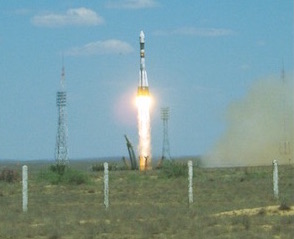 5 June 2016 marked the tenth anniversary of the PAMELA (Payload for Antimatter Exploration and Light-nuclei Astrophysics) satellite detector, the space observatory for the study of cosmic rays, currently in orbit at 560 km above the Earth. Launched in 2006 with a Soyuz rocket from the Baikonur base in Kazakhstan, included on board the Russian satellite Resurs-DK1, for all this time PAMELA has been acquiring data and obtaining fundamental results. The result of an Italo-Russian collaboration also involving Germany and Sweden, the mission is led by INFN and supported by the Italian Space Agency (ASI).
5 June 2016 marked the tenth anniversary of the PAMELA (Payload for Antimatter Exploration and Light-nuclei Astrophysics) satellite detector, the space observatory for the study of cosmic rays, currently in orbit at 560 km above the Earth. Launched in 2006 with a Soyuz rocket from the Baikonur base in Kazakhstan, included on board the Russian satellite Resurs-DK1, for all this time PAMELA has been acquiring data and obtaining fundamental results. The result of an Italo-Russian collaboration also involving Germany and Sweden, the mission is led by INFN and supported by the Italian Space Agency (ASI).
Certainly among the most significant and promising scientific contributions of the mission, the first measurement of high-energy positron and antiproton streams has over the years enabled a new field of investigation on dark matter to be opened. Great interest was aroused, in particular, by the excess of positrons detected by PAMELA and published in Nature in the first half of 2009. Various explanations have been advanced by theoretical physicists in the more than 1,400 articles subsequently published.
Contributions from the annihilation of dark matter or from pulsars, or changes in the propagation models of cosmic rays in the Galaxy have been postulated. Noteworthy were also the results of the measurements performed on proton and helium nuclei streams, i.e. almost all cosmic radiation, up to one billion MeV and published in Science in 2011. PAMELA for the first time demonstrated that these particles have slightly different energy spectra between the two species and have a change of slope at high energies. This data has shed new light on the mechanisms of production, acceleration and propagation of cosmic rays in our Galaxy. Among the results that have aroused great interest, also outside the scientific community, is the unexpected discovery of an antiproton belt around the Earth. Finally, the latest experiment data, published in Physical Review Letters on 13 June last, demonstrate for the first time with extreme clarity the effects of solar activity and the magnetic polarity of the Sun on cosmic rays, also providing unique information on heliosphere mechanisms.
PAMELA is conducted by an international team, led by INFN and with the support of the Italian Space Agency, consisting of the INFN Sections and Departments of Physics of Trieste, Florence, Rome Tor Vergata, Naples and Bari, the Frascati National Laboratories, the IFAC Institute of the CNR, the NRNU MEPhI and the Fian Lebedev in Moscow, the Joffe Institute in St. Petersburg, the University of Siegen in Germany and the
Royal Technical Institute in Stockholm. The Russian Space Agency also built the Resurs-DK1 satellite and the Soyuz rocket. The individual parts of the instrument were built in the various laboratories with the support of numerous companies, especially Italian. the integration of the instrument prior to launch took place in the laboratories of the INFN section and Department of Physics of Rome Tor Vergata






